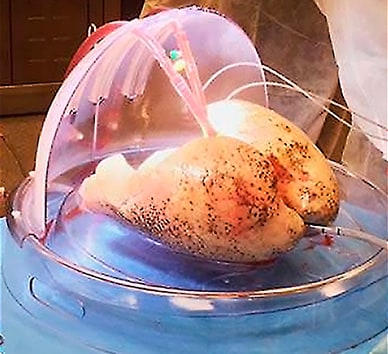Sept. 12, 2018
The care of patients with progressive lung disease has been transformed by orthotopic lung transplantation. This therapy, limited by the number of donor organs and by the need to select patients who are able to tolerate the twin demands of surgery and immunosuppression, nevertheless offers the potential of years of disease-free living.
Ex vivo perfusion and ventilation of a donor lung

Ex vivo perfusion and ventilation of a donor lung
A partnership explores ex vivo lung perfusion and ventilation to resuscitate and support donor lungs that would otherwise be unavailable for transplant.
As the nationwide need for organs continues to grow, the shortage of donor lungs is a major limitation. It is estimated that less than 20 percent of all donor lungs are suitable for transplant. In the face of such a shortage of donor organs, Mayo Clinic in Jacksonville, Florida, is developing novel approaches to maintaining donor organs. In a unique academic-industry partnership with United Therapeutics Corp., Mayo Clinic is furthering the study of ex vivo lung perfusion and ventilation to resuscitate and support donor lungs that would otherwise be unavailable for transplant.
This technology, which is currently confined to use within clinical trials, delivers low-pressure oxygenated perfusate that comprises hyperosmolar solutions to isolated organs, combined with protective (low-pressure, low-inspired oxygen) ventilation, and close monitoring for indicators of improving function. Ex vivo lung perfusion (EVLP) offers the potential of providing many more organs for transplant.
 Lung restoration center at Mayo Clinic's campus in Florida
Lung restoration center at Mayo Clinic's campus in Florida
Construction of a three-story lung restoration center at Mayo Clinic's campus in Florida will begin in 2017.
The combined venture is a multiyear development with plans to begin construction of a three-story lung restoration center within the heart of Mayo Clinic's campus in Florida in 2017. This facility will house the lung perfusion program as well as space for research carried out by the Center for Individualized Medicine and Center for Regenerative Biotherapeutics, to further investigation for years to come. All three Mayo Clinic sites now have active lung transplant programs; Mayo Clinic's campus in Arizona launched a program in 2016.
Nationwide, one-year survival following lung transplant continues to improve, but longer term outcomes remain a challenge, due in large part to chronic allograft rejection from bronchiolitis obliterans, characterized by inexorable small airways obstruction. Management is aimed primarily toward prevention, but strong evidence is lacking for a specific approach. In the absence of any reliable treatments for established bronchiolitis obliterans, investigators from Mayo Clinic in Jacksonville, Florida, are conducting a clinical trial of mesenchymal stem cells in lung transplant recipients with chronic rejection.
Patients with interstitial lung disease, who have the highest death rates among patient diagnostic groups awaiting transplant, make up one of the largest groups referred for transplantation. The current allocation system favors such patients by adjusting the lung allocation score based on underlying disease, in the hopes of a more timely intervention. However, patients may still wait several years. Additional strategies include the use of donor lungs following cardiac death and the traditional donors following brain death, although the former involves a more resource-intense commitment from the transplant procurement team.
The patient with interstitial lung disease presents a few unique challenges, particularly if the lung condition is a manifestation of a systemic disease such as a rheumatologic disorder. The activity and course of extrapulmonary manifestations may impact the patient's candidacy for transplant. Finally, because the new anti-fibrotic agent nintedanib has been associated with arterial thrombosis, this drug is typically discontinued upon the patient's listing for transplant.
The decision concerning single- or double-lung transplantation is often of major concern to patients and is influenced by organ availability, age and functional status — single lung is generally a shorter, less complex operation — as well as past surgical history, but in general, carefully selected patients have good quality of life and often excellent lung function after single-lung transplantation.
For more information
Mayo Clinic. Mesenchymal Stem Cell Therapy for Lung Rejection. ClinicalTrials.gov.
Lung Bioengineering Inc. Extending Preservation and Assessment Time of Donor Lungs Using the Toronto EVLP System at a Dedicated EVLP Facility. ClinicalTrials.gov.